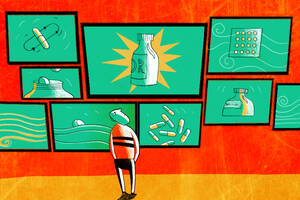Entrepreneurship Innovation Aug 3, 2017
Waiting to Protect Intellectual Property Could Doom Your Startup
Patent attorneys offer four tips for entrepreneurs on safeguarding ideas from the get-go.

Michael Meier
Does your fledgling startup really need to pour time and money into protecting its intellectual property?
Most likely, yes, says R. Mark McCareins, a clinical professor of business law at the Kellogg School and former senior partner at the law firm Winston and Strawn LLP. “Almost every startup has an idea that’s probably worth protecting, whether it’s a piece of software or a bit of code or a totally new invention.”
Yet for many early-stage entrepreneurs, intellectual property (IP) is an afterthought, a topic for consideration once the product has been developed, the business plan has been put in place, and discussions with potential investors or customers are already in the works.
McCareins recently sat down with Pete Slawniak, an intellectual property lawyer at Argonne National Laboratory, and advisor to Argonne’s startup incubator called Chain Reaction Innovations.
Their conversation touched on what startups of all stripes should know about patents, nondisclosure agreements, and the wisdom of using that inexpensive online legal service.
Here are some takeaways from their discussion, edited for length and clarity.
Think about IP early on—while you are still developing your product.
Slawniak: As soon as a company starts to invest in research and product development, it’s time to begin planning some sort of protection for that investment. Ideally, this happens when a company is evaluating its business strategy. The question to ask is, “Will this intellectual property offer competitive advantage?”
It’s never too early to think about this, because preliminary groundwork agreements—whether that’s a grant application, an incubator membership, or some sort of joint venture agreement—are all going to have IP terms.
McCareins: If you don’t address IP early, you run the risk of either A, spending all this money in research and development on something that isn’t patentable, or B, incubating with a third party, but because you have not protected your IP rights sufficiently, you allow the third party or others to extract your IP away from you without you even knowing it.
Slawniak: U.S. patent law is very generous—you have up to one year from the date of a public disclosure to file a patent application. But in most other countries, you lose patent rights as soon as there’s a public disclosure of the invention.
And public disclosure doesn’t have to be a sale: it could be an advertisement or even testing a prototype out there on the street without having nondisclosure agreements in place. Let me give you just one anecdote from an old case that jumps to mind: an inventor designed and prototyped a great new motor for their boat – something that had serious market potential. Then that inventor went on a boating trip with one of his friends. Many years later, when that inventor went to enforce his patent against a competitor, lo and behold, the court deemed the boat trip a public disclosure that invalidated his patent rights, even though the friends never knew how the motor worked. That should serve as a cautionary tale about disclosing an invention.
So it’s important to start thinking about patents even before you start talking to any potential customers and attempting to monetize an idea.
Yes, nondisclosure agreements (NDAs) are worth the hassle.
McCareins: I see inventor-types saying, “I don’t want to scare off people with some overly legalistic document. I don’t really want to spend the money right now on an NDA. I think you’re putting the cart before the horse.”
But “trusting” somebody with information that can potentially cause a public disclosure is just not worth the risk. So if there’s a personal risk that you may offend somebody by requiring an NDA, you’ve got to balance that against the long-term legal ramifications of not getting it. In my experience, it’s always better to demand the NDA.
Slawniak: I couldn’t agree more. And then the NDA sets the expectations of both parties. It’s better to set those expectations up front rather than leave them ambiguous and subject to interpretation—or misinterpretation. If somebody doesn’t want to sign an NDA, you might want to think about whether or not this is the right person to show your technology to at this point.
It pays to be certain your idea is original.
McCareins: A prior art search needs to be done to make sure that what you’re getting patented is really and uniquely your own. There may be a temptation not to do a comprehensive search because it’s expensive, but you don’t want to find out later that someone had the same invention.
People say, “Well I got a patent so I’m good to go,” but that’s only half the battle. Even when the U.S. Patent and Trademark Office has granted a patent, that doesn’t mean a federal court might not come in later and invalidate that patent based on another party’s complaint.
Slawniak: When you file a patent, look around and do a search. See what other folks in the industry are doing. See what other patents are out there. Read the scholarly work around technology in your field and have some conversations with people in the industry. Your patent is a reflection of your R&D investment and your technological advantage, so it’s important to know exactly where that product differentiation is. An exhaustive search will ensure you have a strong patent, and hopefully help your patent issue faster. When you have something you believe has value, it’s worth the investment of time to develop and protect it.
Even lean startups shouldn’t skimp on protecting IP.
McCareins: Startups are often frustrated by the time that it takes to get the patents done right.
I usually caution against using online sites that provide legal services for patent protection quickly and cheaply because this is too important to do on that level. It’s like having brain surgery done at a drive-through clinic.
Slawniak: In my experience, it takes about two months to get a thorough and well-researched patent application with broad claims on file. Interestingly, I have seen that the product improves during that time, because you have a more robust discussion about what the competitors are doing, and you learn some potential shortcomings about your own product. So yes, it takes time, but what many folks don’t realize is that this is actually part of the competitive evaluation and product-development process.
“People say, “Well I got a patent so I’m good to go,” but that’s only half the battle.” —Mark McCareins
McCareins: It’s like looking at a half-frozen apple pie in the oven. You’re hungry, but you know you should let it bake for another fifteen minutes.
Slawniak: As for money, if it’s your fourth or fifth add-on patent in the area, don’t overspend. As for the others, ultimately, you’re going to get what you pay for.
If you’re bootstrapping your business, the ten to fifteen thousand dollars that it costs to file a patent application can seem like a lot. But if you want to attract angel investors—and, hopefully VC investors—you’re going to need to assure people that your idea won’t be snatched up by some larger incumbent.
McCareins: Plus, if I’m talking to people about investing in my idea, the fact that you’ve gone to a reputable firm that specializes in IP, gotten a good nondisclosure agreement, and done the patent due diligence—that tells outside people, “hey, these people are serious and they know what they’re doing.”
Don’t forget foreign jurisdictions, including where you’ll want to grow in the future.
McCareins: If you have a product that has some usage outside of the U.S., you’ll want to get into foreign jurisdictions early with competent counsel. Because one slip-up in, say, an Italian patent filing could cause a huge ripple effect in other jurisdictions.
Slawniak: Absolutely. With supply and distribution chains becoming more international, you need to be aware not only of the market in which you’re operating, but the market in which your suppliers are operating. It’s common now to see lawsuits in more than one country, so you want to be protected in all relevant markets.
You also want to think ahead. Where do you envision growth? A decade ago, it was rare for an American company to file for patent protection in China, but now we’re seeing more and more filing over there. The reason is clear: it’s a huge market, and IP protection is quickly becoming just as important and mature as in more established markets.
Editor’s note: Mr. Slawniak’s views are his own and not representative of the University of Chicago, UChicago Argonne LLC, or the Department of Energy.



